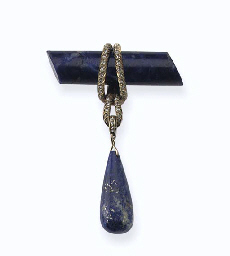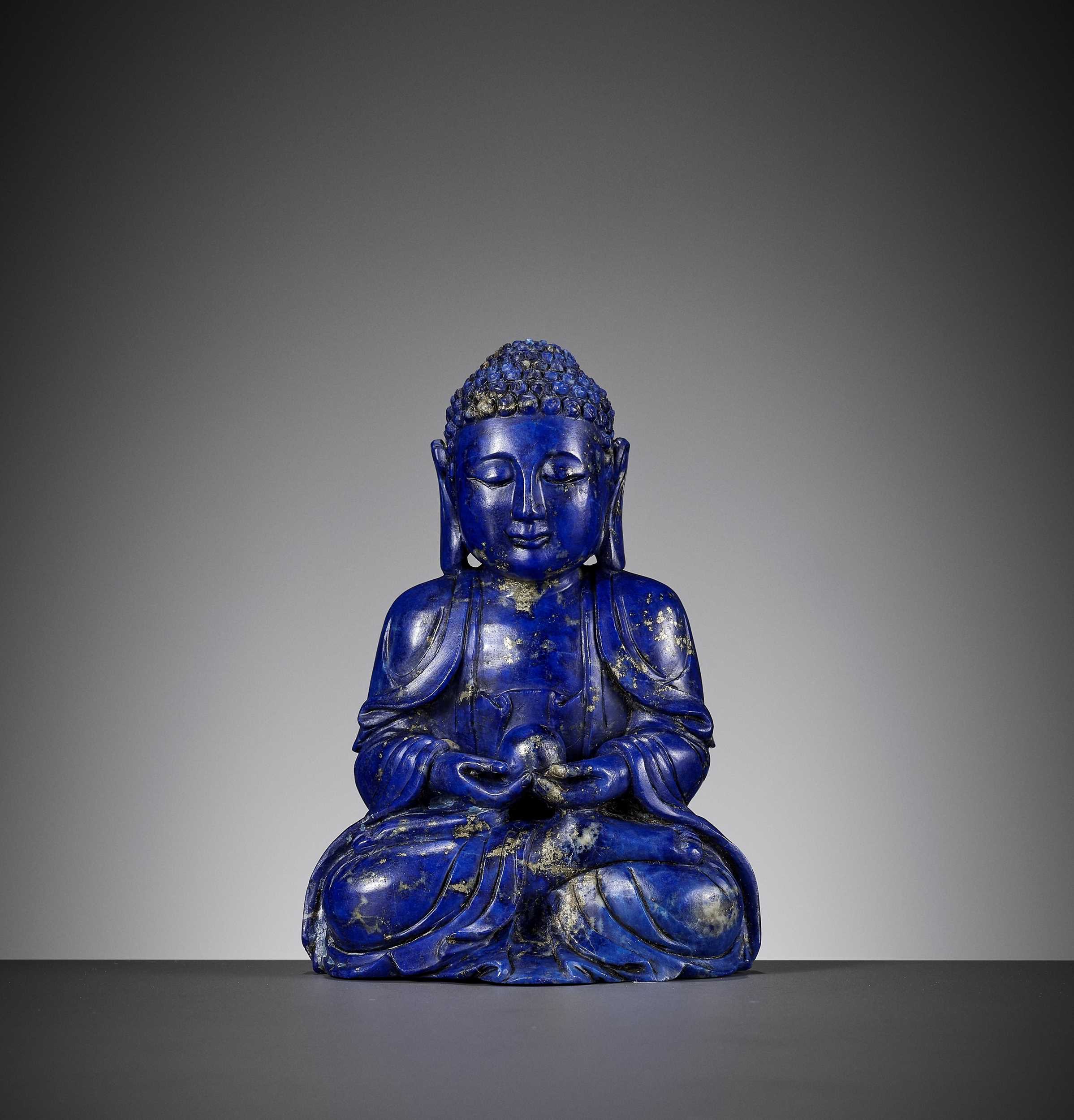China, 1736-1795. Superbly carved in the round as a bear standing foursquare in an alert position with the head facing forward, the beast realistically portrayed with taut muscles and prominent spinal column terminating in a short tail swept to one side. The small funnel-form ears pricked, the face framed by neatly incised lines simulating fur, the pierced mouth opened to reveal sharp fangs. Provenance: French private collection. Condition: Very good condition with minor wear, the ears with small chips and one old fill, minor losses to paws, the stone with natural fissures, some of which may have developed into small hairline cracks over time and possibly show old fills. Weight: 1,242 g Dimensions: Length 16.2 cm, Height 12.3 cm The eyes are finely inlaid in amber, their backsides hollowed and the black pupil either painted inside or more likely additionally inlaid in dark horn, the pupils appearing to follow the viewer from all angles. The manually polished stone is of an intense, deep blue color with ivory white shadings, gray patches and gold flecks, all masterfully utilized by the master lapidary to make the beast appear as a polar bear. Bears were, from the Western Han dynasty onwards, represented in bronze both as free-standing sculptures and as highly decorative parts of larger ritual vessels. These free-standing sculptures of bears are likely to have been made in sets of four, used as opulent mat weights. Examples include two near-identical gilt-bronze bears, the first from the collection of Senator Hugh Scott, Washington, included in the exhibition Ancient Chinese Bronzes and Gilt Bronzes from the Wessen and Other Collections, Eskenazi Ltd, London, 1980, cat. no. 22, the second from the collection of Robert Hatfield Ellsworth, sold at Christie’s New York, 17th March 2015, lot 1. The use of a bear as a design element, in one of the feet that supports an elaborate Han vessel, can be seen on an inlaid gilt-bronze vessel in the National Palace Museum, Taipei, included Art in Quest of Heaven and Truth, Chinese Jades through the Ages, National Palace Museum, Taipei, 2011, cat. no. 7-3-10. The shape of the vessel is highly dynamic, showing the bear poised, bristling with energy, holding a ball in one hand. It was so admired by the Qianlong Emperor that he personally ordered an exact copy to be made in wood and sent to Suzhou as a model for a jade copy. The successful jade zun vessel, of superlative quality and very close to the bronze prototype, is now also in the National Palace Museum, illustrated ibidem, cat. no. 7-3-9. Lapis lazuli was highly prized during the Qianlong period, as evidenced by a pair of Qianlong period stone lions dyed to imitate the stone, included in the exhibition Tributes from Guangdong to the Qing Court, Hong Kong, 1987, cat. Nos. 71 and 72, and a Qianlong period lapis lazuli mountain in the Asian Art Museum of San Francisco, illustrated in Michael Knight, He Li and Terese Tse Bartholomew, Chinese Jades, San Francisco, 2007, plate 354. Expert’s note: The extravagant use of this highly precious material, carved in a consciously naturalistic style, clearly indicates the present bear is a unique work of the Qianlong period, created in the Palace Workshops for the pleasure of the Emperor and his entourage. The exceptional manual polish with its unique unctuous feel and lustrous shine as well as the fine inlay technique further underpin this fact. While common wisdom dictates that the Imperial workshops only used the purest materials, it would take the most accomplished of all master lapidaries to create such a splendidly vivid carving which utilizes all the present natural inclusions and shadings of the stone in such a breathtaking manner – or in short: one of the most impressive Chinese animal sculptures this author has ever seen. Auction result comparison: Compare a related lapis lazuli water buffalo, dated to the 18th century, of only slightly larger size (20.5 cm long), at Christie’s Hong Kong in Imp
China, 1736-1795. Superbly carved in the round as a bear standing foursquare in an alert position with the head facing forward, the beast realistically portrayed with taut muscles and prominent spinal column terminating in a short tail swept to one side. The small funnel-form ears pricked, the face framed by neatly incised lines simulating fur, the pierced mouth opened to reveal sharp fangs. Provenance: French private collection. Condition: Very good condition with minor wear, the ears with small chips and one old fill, minor losses to paws, the stone with natural fissures, some of which may have developed into small hairline cracks over time and possibly show old fills. Weight: 1,242 g Dimensions: Length 16.2 cm, Height 12.3 cm The eyes are finely inlaid in amber, their backsides hollowed and the black pupil either painted inside or more likely additionally inlaid in dark horn, the pupils appearing to follow the viewer from all angles. The manually polished stone is of an intense, deep blue color with ivory white shadings, gray patches and gold flecks, all masterfully utilized by the master lapidary to make the beast appear as a polar bear. Bears were, from the Western Han dynasty onwards, represented in bronze both as free-standing sculptures and as highly decorative parts of larger ritual vessels. These free-standing sculptures of bears are likely to have been made in sets of four, used as opulent mat weights. Examples include two near-identical gilt-bronze bears, the first from the collection of Senator Hugh Scott, Washington, included in the exhibition Ancient Chinese Bronzes and Gilt Bronzes from the Wessen and Other Collections, Eskenazi Ltd, London, 1980, cat. no. 22, the second from the collection of Robert Hatfield Ellsworth, sold at Christie’s New York, 17th March 2015, lot 1. The use of a bear as a design element, in one of the feet that supports an elaborate Han vessel, can be seen on an inlaid gilt-bronze vessel in the National Palace Museum, Taipei, included Art in Quest of Heaven and Truth, Chinese Jades through the Ages, National Palace Museum, Taipei, 2011, cat. no. 7-3-10. The shape of the vessel is highly dynamic, showing the bear poised, bristling with energy, holding a ball in one hand. It was so admired by the Qianlong Emperor that he personally ordered an exact copy to be made in wood and sent to Suzhou as a model for a jade copy. The successful jade zun vessel, of superlative quality and very close to the bronze prototype, is now also in the National Palace Museum, illustrated ibidem, cat. no. 7-3-9. Lapis lazuli was highly prized during the Qianlong period, as evidenced by a pair of Qianlong period stone lions dyed to imitate the stone, included in the exhibition Tributes from Guangdong to the Qing Court, Hong Kong, 1987, cat. Nos. 71 and 72, and a Qianlong period lapis lazuli mountain in the Asian Art Museum of San Francisco, illustrated in Michael Knight, He Li and Terese Tse Bartholomew, Chinese Jades, San Francisco, 2007, plate 354. Expert’s note: The extravagant use of this highly precious material, carved in a consciously naturalistic style, clearly indicates the present bear is a unique work of the Qianlong period, created in the Palace Workshops for the pleasure of the Emperor and his entourage. The exceptional manual polish with its unique unctuous feel and lustrous shine as well as the fine inlay technique further underpin this fact. While common wisdom dictates that the Imperial workshops only used the purest materials, it would take the most accomplished of all master lapidaries to create such a splendidly vivid carving which utilizes all the present natural inclusions and shadings of the stone in such a breathtaking manner – or in short: one of the most impressive Chinese animal sculptures this author has ever seen. Auction result comparison: Compare a related lapis lazuli water buffalo, dated to the 18th century, of only slightly larger size (20.5 cm long), at Christie’s Hong Kong in Imp







.jpg?w=400?width=1600&quality=70)





Try LotSearch and its premium features for 7 days - without any costs!
Be notified automatically about new items in upcoming auctions.
Create an alert